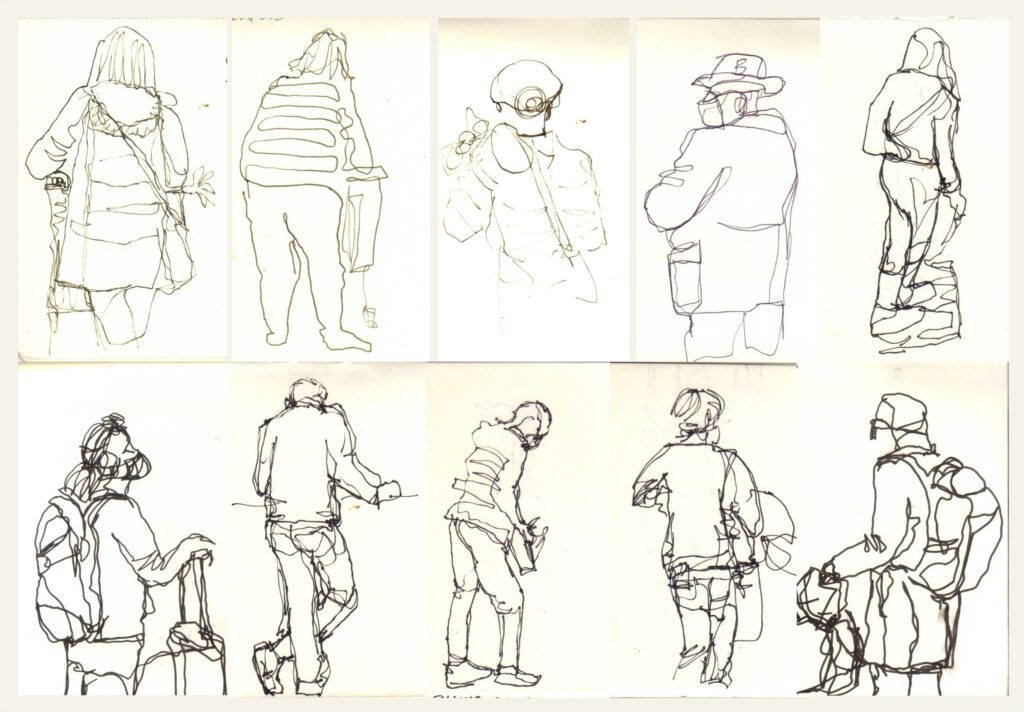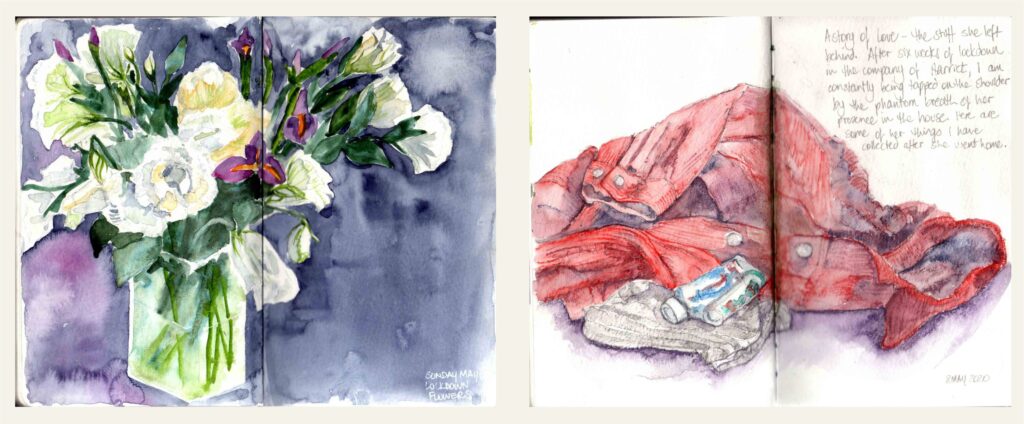ISOLartION – Lori Bentley on the story of lockdown in pictures
This is our last edition of Season 2 of our weekly IsolARTion series. We are planning two more bumper editions at the end of April and May, but for now, please go back and enjoy the wealth of talent and inspiration in both seasons of the series.
As we mark a full year of fighting this pandemic is seems appropriate to feature the Society’s webmaster and graphic designer, Lori Bentley, who reflects on a year of COVID in another country.
My profile with the SEAW is relatively invisible. I am the webmaster, virtual assistant, sometime answerer of emails and designer of exhibition posters. Although I studied fine art, I primarily work as a designer, illustrator and website builder. I started my work for the SEAW as a favour to my sister, Vandy, who needed an exhibition poster designed, and after a few years, the committee decided to employ me to redesign the website and help with all things digital. Unlike all SEAW members, I don’t live in East Anglia. I live 12 980 km away, in Johannesburg, South Africa.
Surviving lockdown in South Africa
In March 2020, South Africa went for an extreme lockdown. Until the end of April we were only allowed out to buy essentials, we could not travel further than 5km from our homes and we could not cross provincial borders without an official permit. We had to wear masks if we stepped outside our homes and we were not allowed to exercise in public spaces. And of course, no alcohol sales. My art sanity was provided by the IsolARTion articles I was setting up for SEAW every week and the Urban Sketchers (USk) community. Because urban sketchers could not meet up to sketch together, the organisation set up weekly video interviews with sketchers from all over the world called USk Talks. Each week, the guests set a challenge based on their particular style, interest or the theme of the talk. These challenges along with those set by my local Johannesburg USk chapter, made it easier to put pencil, pen and paint to paper.
Sketchbooks
I have always carried sketchbooks with me (especially when travelling), but in lockdown, I had two. The smallest (8 x 12 cm) came with me on essential trips out of the house where I found ample opportunity to do quick continuous line drawings of people in the queues. Have you noticed that social distancing in queues means that you have more space to view your subjects?
The bigger sketchbook (A5 moleskine watercolour journal) became the vehicle for documenting my year. I started pre-lockdown on 26 January with a Chinese New Year festival at the huge Nan Hua temple complex in Bronkhorstspruit (East of Pretoria). Ironically, a lot of the workers at the festival were wearing masks and as we had just started hearing about the virus, I remember wondering if it was safe to be in the crowd.
Documenting life in lockdown
As lockdown loomed my sketchbook became a chronicle of ordinary life in the pandemic.
March: In preparation for stocking up on essential groceries, I cleaned out a storage cupboard and got rid of the old and expired “condiments that time forgot”. I missed one jar of stuff which resulted in this sketch. I thought this was a good visual metaphor for social distancing.
April: A challenge from my local USk chapter, to draw a 180-degree view resulted in this bedroom sketch.
Easter weekend: Two drinks – jasmine tea in a porcelain cup and a precious gin and tonic on Easter Sunday (no refills to be bought if you run out)
My local urban sketchers were doing “blind” continuous line self-portraits. As I was using continuous line in my queue sketches, I decided on the “blind” aspect of the challenge – I took off my reading glasses which meant I could see my reflection clearly, but the marks I was making on the paper were fuzzy.
April: Not being able to sketch outside, I turned to interior landscapes for my subject matter. Two bathroom windows, drawn in different media. And sewing face masks became the subject of a comic book sequence.
In May, we could finally buy flowers and the local flower man ran out of stock in the space of a morning. Everyone seemed overjoyed to add a bit of beauty to their homes as flowers had been deemed non-essentials and the flower buckets had been sadly empty since March.
My younger daughter left to go back to her digs and I completed an USk Talks challenge: to draw a story of love. The sketch showed all the items she left behind like ghosts of her presences. I revisited this theme in my “Holding things together“ piece for Lillias’s competition. The Holding things together piece was also featured in last week’s USk Talk as an example of illustrating loss.
June: These barn owlets were found cold and dehydrated, in a warehouse 150 km east of Johannesburg. My older daughter, a vet, received them as patients, and started the hydration and warming up. She contacted a specialist wildlife veterinary hospital and arranged to meet at my house for a patient transfer. I got to see my daughter for the first time in months and met the owlets in their blankets. I baked a cake as soon as I heard she was driving through to Johannesburg. Isn’t it amazing how we value all those tiny moments of connection so much more now? This sketch was also featured on the Season 1 finale of USk Talks
August: A nest I found in the gutter while out on a walk, once we were allowed to exercise outside of our homes.
We had to say goodbye to two much-loved old dogs in 2020. I had used them as subjects for sketching in April and July. I am glad I did!
Then, quite suddenly, our borders opened up and a many-times-rebooked trip to the UK became a reality. October and November were spent in the UK, setting up the first SEAW online exhibition, seeing family and attending a few classes, including Stephie Butler’s liquid charcoal and watercolour workshop. As a result, my sketchbook acquired some cold weather landscapes in water soluble graphite (which I prefer to the charcoal) and watercolour. Three of these sketches would lead to commissions for finished paintings by a collector back in South Africa who wanted the bare branched images for her sunny African office.
I made it back to South Africa before our respective COVID variants shut everything down again. (It wasn’t me, I promise, I had tests).
By the end of 2020 I had completed four sketchbooks. Two large ones documenting the year, and two small ones dedicated to people in queues. Most of the work in them can be found on my Instagram profile.
This process of reportage sketching helped me become more observant of my surroundings and see the stories in everyday objects. I also have the freedom to try out new media and styles. On the whole, 2020 became a very art-driven year which has spilled over into 2021. I have continued to sketch the stories in my everyday life, from orchid leaves, to hair ties to rainbow carrots and more.
Tags In
Search by category
Blog archive
- February 2023
- October 2022
- June 2022
- April 2022
- January 2022
- October 2021
- July 2021
- April 2021
- March 2021
- February 2021
- January 2021
- October 2020
- September 2020
- August 2020
- July 2020
- June 2020
- May 2020
- April 2020
- March 2020
- February 2020
- January 2020
- December 2019
- October 2019
- July 2019
- April 2019
- March 2019
- January 2019
- December 2018
- April 2018














